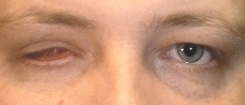The loss of an eye is traumatic not only to the patient but also to those in his or her immediate surroundings. Advanced techniques provided by the oculoplastic surgeon lead to comfortable and aesthetic solutions that restore the natural look.


Sometimes an eye may have to be removed because of a tumour, after severe trauma, or to stop the pain from a chronic painful blind eye.
TREATMENT
After the removal of the eye, the surgeon (often an eyelid specialist) usually inserts an ‘orbital implant’, a small ball which fills up the space left behind by the natural eye.
The muscles which moved the eye are attached to this ball. After about six weeks, you will be referred to an ocularist who will create an artificial eye made to fit your socket. The artificial eye is placed on top of the healed buried implant weeks later, which is a very good match with the remaining eye and should show some movement, but never as much as the other eye.
Even after the placement of an implant, the tissues of the eye socket may shrink over time and result in a sunken hollow appearance. A new artificial eye may then be needed. Sometimes further surgery is indicated to build up the volume in the socket. You should consult your oculoplastic surgeon if this happens.
It is important to protect your remaining good eye and also visit the ocularist once a year to maintain the quality of the artificial eye.
Note: All treatment is preceded by a consultation and examination to establish the correct diagnosis.


